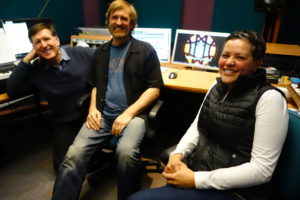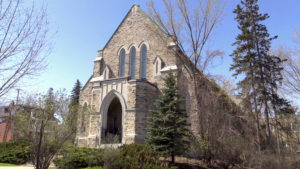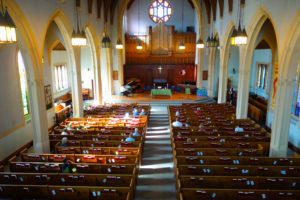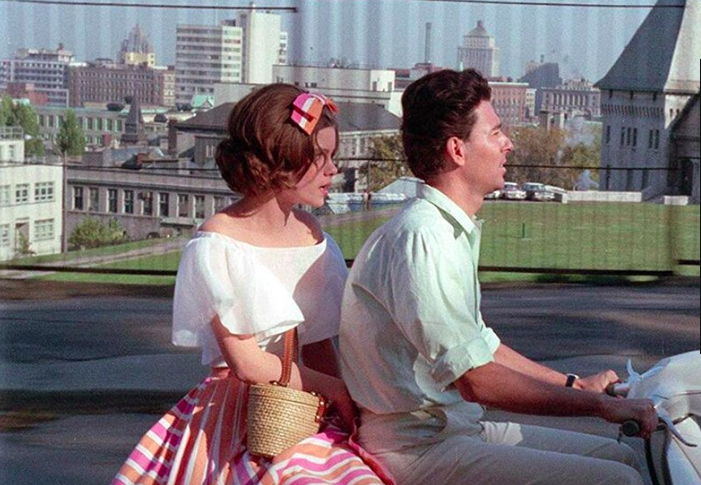Ottawa’s Southminster United Church has been a community mainstay in old Ottawa South for more than 80 years. But with a shrinking congregation, it now faces an uncertain future. Like other churches in Ottawa and Canada, Southminster is struggling to stay open. To that end it has entered into an agreement with a developer to save the congregation. The process is the subject of a new 30-minute film Who Needs Church? (Kublacom Pictures) made by Ottawa filmmakers Ed Kucerak and Danielle Rolfe. People can see a screening on March 23 in Southminister (15 Aylmer Ave.) at 7:30 p.m. There is no entrance fee but donations are welcome. A Q&A will follow with the filmmakers, but beforehand Ed and Danielle answered some questions from ARTSFILE.
Q. Please tell me about yourselves as filmmakers in Ottawa.
Ed: My main focus is documentaries that deal with social justice and human rights issues — such as How Can A Boy about Mynamar’s long civil war and the Karen refugees who settled in Ottawa, and Partners for Peace which shines a voice on Israeli and Palestinian women and their views on peace and how to end the conflict.
Who Needs Church? is the third film that Danielle and I have worked on together. We recently completed Blue Roses and Falling Through the Cracks. Both films deal with providing palliative care to Ottawa’s rooming house community. Blue Roses won the Audience Choice Award at the 2018 One World Film Festival.
Danielle: I am new to filmmaking, but have been fortunate to have received a JumpStart Mentoring Grant from SAW Video, and to have had the opportunity to learn documentary storytelling from Ed. My experience as a community-based health researcher has also allowed me to combine this type of research (talking to people about their health, the healthcare system, and how both can be improved) with film-making to more easily communicate research findings to a broad audience.

From left: Ed Kucerak, audio editor Andrew Huggett and Danielle Rolfe.
Ed: I’m also interested in making documentaries that reflect our community. For example, One of the Last was about Ottawa’s Rideau Bakery, My sense is that there aren’t many documentaries being made about Ottawa stories that need to be told. I feel as a filmmaker it’s my responsibility to tell these stories and have them available for current and future generations. In a way creating Ottawa’s time capsules.
Danielle: Given my background in healthcare research, I am drawn to films about social justice, particularly as it relates to equity and access to healthcare. Recently, Ed and I had the privilege of working with Ottawa Inner City Health and the Somerset West community in Ottawa to create Blue Roses and Falling Through the Cracks, about the need for palliative care for people living in poverty in rooming houses. I felt that this film was important as revealed the strength of people who live on the margins, and what is possible when they are supported to create solutions to complex problems like poverty. Who Needs Church? has a different focus, as it draws on my personal interest in the human need for connection and compassion.
Q. Who Needs Church? is very current. Why did you want to make this film?
Danielle: I wondered whether anyone would notice if the churches closed. Who would it affect? Would we lose anything as a community? I started by asking many people, church goers and non-church goers, the question, ‘Who needs church?’ I already knew that mainline church-goers are aging, and Sunday service doesn’t draw in many people, but in making the film, I learned that churches, despite our nonchalance about closures, are actually integral to many of our social programs, and our most vulnerable community members are more likely to be negatively affected.
Ed: National Trust for Canada, a national heritage charity that works to save old buildings, estimates that 9,000 religious spaces in Canada will be lost in the next decade, which represents roughly a third of all faith-owned buildings in the country. Putting aside the religious and spiritual aspects of these places of worship, they have been for generations, and continue to be, centres for community programs and activities. They are also beautiful historic buildings which will be lost forever.
I felt that this would be the basis for a good film and something that needed to be told.

Southminster United Church has been serving the Old Ottawa South community for more than 80 years. The church opens its doors to the whole community and each year there are more than 70,000 visits to participate in a variety of community programs.
Q. What was the spark for the film?
Danielle: For me, the spark was starting to attend Sunday services at Southminster United Church (15 Aylmer Ave.), seeing the many social justice initiatives going on at the church, and wondering how the next generation, and our communities without church-goers and churches, would maintain these important initiatives if churches ceased to exist.
Ed: Danielle had approached me and asked if I was interested in helping her produce her first film. I felt that Danielle’s project had all the elements needed to make a compelling film. And I was interested in documenting the struggle of a landmark church to survive, and the conflicting views about the impact that the development would have in our community.
Q, Is Ottawa a microcosm of a much larger provincial and national trend?
Ed: Churches have been closing for some time across the country for many reasons from dwindling congregations, high operational and maintenance costs, and that we have become a secular society.
We felt by focusing on churches in Ottawa, and especially the redevelopment of Southminster United Church, we could easily convey the bigger picture of what is happening across the country.
Danielle: We focused on Ottawa for pragmatic reasons – we live in Ottawa and the redevelopment of Southminster was a hot topic in our neighbourhood. However, in the course of making the film, I learned that Ottawa is a microcosm of a much larger provincial and national trend of mainline churches closing or having to redefine their role within communities. However, as Southminster’s Rev. Trisha Elliott points out, declining membership is not a problem unique to churches. It is evident in all community-based organizations. She suggests, and I would agree, that this speaks to a broader social phenomenon of fewer people wanting to join organized institutions, and perhaps, a more individualistic society.
Q. Important, historic, church buildings in Ottawa are being transformed. I’m thinking also about St. Brigid’s, Dominion-Chalmers and All Saints in Sandy Hill? Does the film deal with these developments?
Ed: Our main focus in the film is Southminster United Church at the corner of Bank Street and Aylmer Avenue, which has been a cornerstone in the old Ottawa South Community for more than 80 years. This allowed us the framework to show the struggle of churches to survive, and also to explore the larger question ‘Is the church a necessary part of our modern lives and community?’ We do touch on other churches that are being transformed or have been transformed such as All Saints in Sandy Hill, Festival House in Westboro and Dominion Chalmers in Centretown.
Danielle: The film does address the fact that many other beautiful and historic churches in Ottawa are being transformed. In the film, Patrick Langston (author of Altared: Renovating the House of God in Ottawa Magazine) and Reverend Tom Sherwood discuss various Ottawa-area churches that have been repurposed.
Many of these developments have been creatively reinvented. But when we lose public access to these buildings, I think we have lost a key aspect of our community.
Q. Does it matter that we repurpose these historic community spaces?
Ed: I think that it does matter where possible to repurpose these historic community places as they are part of our heritage. Many of them are beautiful architectural buildings. If they can in some way serve a new purpose, all the better for the community.
Danielle: I think that these transformations are critical to congregations’ and the buildings’ survival. However, what I worry about is whether church structures will remain as places where people can make meaningful connections spiritually and with others, or whether they will just be given over to private developments that don’t serve the community.

In the Southminster sanctuary.
Q. Churches are more than buildings. They are a gathering place. What kind of people were you talking to?
Danielle: We spoke to people who attend church and those who do not, church leaders, and people who run or rely on programs that are run within churches, such as emergency food centres, Out of the Cold Supper guests, and many others. I was surprised by their answers — almost everybody recognized the importance of churches to community, but this widespread support does not seem to play out on Sunday morning.
Q. We are a more secular society. Church attendance has been falling for years. Does that matter?
Danielle: I don’t think that churches, or religion, is vital to our society’s wellbeing, but I do think that having a sense of connection to others within our community and a greater power and purpose beyond our individual lives, is. When we lose these aspects within our lives, we feel isolated and lonely. If we can maintain spaces within our communities where people can feel a sense of belonging and can contribute to making our world a better place for everybody, then perhaps churches aren’t necessary, but they are a pretty strong foundation to start with.
Ed: As places of worship disappear, regardless of which religion or spiritual practice, we are losing a sense of community and belonging. So it does matter if we as a society want live in a vibrant, meaningful, compassionate and caring environment.
What I think is important to note is that the film is not about religion or faith. It’s about loss and the impact that the closing of a church has on a community. Where do the those most vulnerable go for help? I think of Centretown United on Bank, St. John’s on Elgin, St Luke’s on Somerset West and St Joe’s on Laurier East: they all provide food, meals, clothes and the necessities in life to those in need. What happens if they can no longer provide these services?
Danielle: My hope for the film is that it is the beginning of many important conversations that we need to have about our communities, and our need for connection with others.







